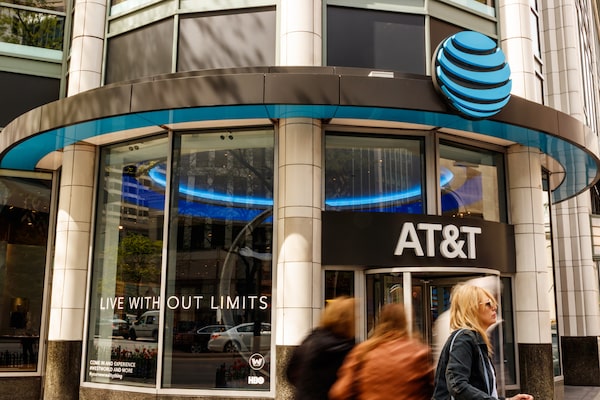
AT&T is among the top holdings in BMO’s high-yield, covered-call ETF, recommended by one portfolio manager for Canadians who want U.S. dollars to help fund their winter breaks south of the border.Jonathan Weiss/JetCity Image/iStockPhoto / Getty Images
For yield-thirsty investors, there’s nothing like a steady pay cheque.
Although it’s common for exchange-traded funds (ETFs) to pay quarterly distributions, more dividend-oriented funds now offer monthly payouts.
These regular payments can help investors manage their cash flow better, provide faster compounding if reinvested and offset losses during market volatility. Of course, the dividend yield rises when the stock price falls – and vice versa.
We asked three ETF experts for their top picks among Canadian- and U.S.-dollar ETFs that offer a monthly income stream.
Daniel Straus, vice-president, ETFs and financial products research at National Bank Financial Inc.
The pick: iShares Core MSCI Canadian Quality Dividend ETF (XDIV-T)
Management expense ratio (MER): 0.11 per cent
This Canadian dividend ETF is suitable as a core holding for investors seeking regular income and is also “quite cheap,” Mr. Straus says.
Its methodology screens for quality companies that have characteristics such as stable earnings, high return on equity and low financial leverage. Top names include Bank of Nova Scotia (BNS-T) and TC Energy Corp. (TRP-T). The ETF’s 12-month trailing yield at Sept. 30 was 4.2 per cent.
One risk to this ETF is its more than 60-per-cent weighting in financial services. Canadian investors who own bank or other financial stocks in their portfolios need to be mindful that they don’t end up with an overconcentration in this sector by investing in this ETF, he says.
The pick: WisdomTree U.S. Total Dividend ETF (DTD-A)
MER: 0.28 per cent
This dividend ETF, which invests in more than 800 U.S. stocks, could serve as a core holding for Canadian investors, Mr. Straus says. This fund tracks an index that screens and weights companies by the yield they’re projected to pay in the coming year. Microsoft Corp. (MSFT-Q) and Apple Inc. (AAPL-Q) are top holdings. The fund’s trailing 12-month yield at Sept. 30 was 2.54 per cent.
For Canadian investors, this ETF is best held inside a registered plan or they would be subject to a U.S. dividend withholding tax and have to pay that tax at their full marginal rate, he says. Risks stem from the U.S. market’s high valuations and volatility triggered by some of U.S. President Donald Trump’s tweets, he adds.
Alex Bryan, director of passive strategies for North America at Morningstar Inc.
The pick: iShares Core MSCI Global Quality Dividend ETF (XDG-T)
MER: 0.22 per cent
Investors can benefit from the diversification this global dividend ETF offers as opposed to sticking with a single market, Mr. Bryan says.
“This fund isn’t just going after the highest-yielding names [that could lead to riskier stock picks], but also screens for quality.”
As part of this strategy, the ETF also filters out companies with extremely high payout ratios because they may be unable to sustain dividend payments, he adds. Top holdings include Procter & Gamble Co. (PG-N) and AT&T Inc. (T-N). The 12-month trailing dividend yield at Sept. 30 was 3.21 per cent.
A risk is that this ETF’s value tilt could lag the broader market when that investment style is out of favour, he notes.
The pick: Vanguard High Dividend Yield ETF (VYM-A)
MER: 0.06 per cent
This U.S. high-yield dividend ETF is “one of the cheapest dividend strategies on the market,” Mr. Bryan says.
The fund weights stocks with the highest dividend yields during the past year by market value, but keeps risk in check by holding almost 410 companies, he adds.
The ETF had a 12-month trailing yield of 3.16 per cent at Sept. 30. Top holdings include JP Morgan Chase & Co. (JPM-N) and Johnson & Johnson Services Inc. (JNJ-N). Financials and consumer goods make up the largest sectors.
A risk is the ETF’s 19-per-cent weighting in financials, which would suffer should this sector take a hit, he notes.
The fund should hold up better than the broader market during market downturns, but “not participate fully on the upside,” Mr. Bryan says.
John Hood, president and portfolio manager at J.C. Hood Investment Counsel Inc.
The pick: BMO Covered Call Canadian Banks ETF (ZWB-T)
MER: 0.72 per cent
This Canadian bank ETF, which uses a covered-call options strategy to generate more income, is appealing for yield-seeking investors, Mr. Hood says. “Banks are always increasing their dividends. … and it’s a good conservative play for people who are getting nothing on fixed-income deposits.”
The annualized distribution yield for this fund at Oct. 9 was 5.58 per cent versus 3.74 per cent for BMO Equal Weight Banks ETF (ZEB-TSX). If BMO Covered Call Canadian Banks ETF is held in a taxable account, the premiums generated from covered calls are taxed as capital gains while the dividend income qualifies for the Canadian dividend tax credit.
The ETF’s fee is on the high side, but is justified because the strategy adds value, he says.
The pick: BMO U.S. High Dividend Covered Call ETF (ZWH-T) or BMO U.S. High Dividend Covered Call ETF USD (ZWH-U-T)
MER: 0.71 per cent or 0.72 per cent, respectively
This U.S. high-yield dividend ETF, which incorporates a covered-call options strategy, can provide decent income in either Canadian or U.S. dollars, Mr. Hood says. AT&T and PPL Corp. (PPL-N) are among the top holdings.
The U.S. dollar version may appeal to Canadians who want U.S. dollars to fund their winter breaks south of the border, he says. If the ETF is held in a taxable account, they will miss out on the federal dividend tax credit. The annualized distribution yield on the Canadian version was 6.35 per cent at Oct. 9.
Although the ETF’s fee is pricey, the fund’s managers do add value, he says. A risk is potential volatility in the U.S. stock market, but “dividend payers are [still] a pretty good place to be.”